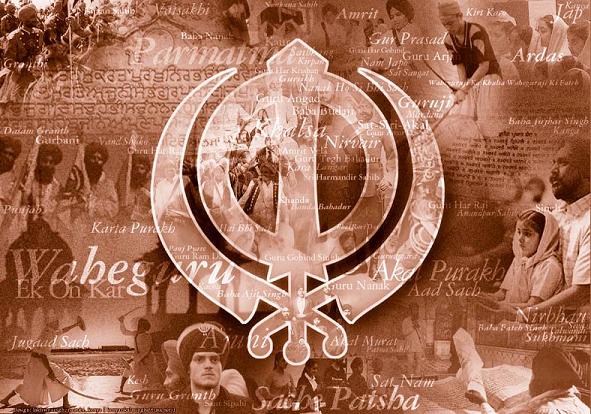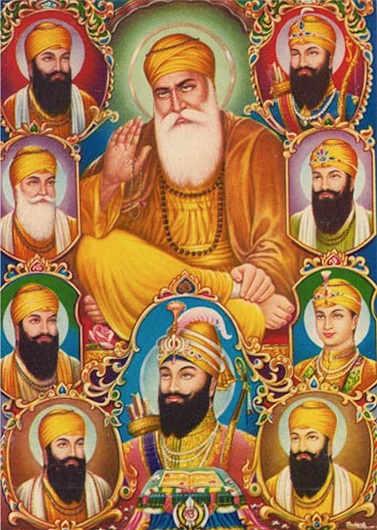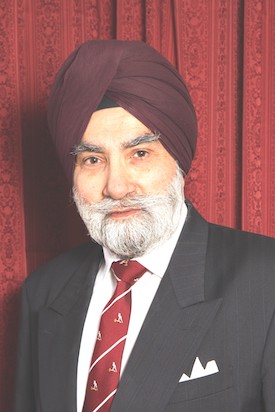(Gurmukh Singh’s paper read at the Sikh Study Forum Conference on 6 November, 2004)
Death is a privilege for the brave, if they die for a noble cause
(Guru Nanak (1469 – 1539), Guru Granth Sahib p.579)
When this mortal life reaches its limits
May I die fighting with limitless courage
(Guru Gobind Singh (1666 – 1708)
Introduction
A retired General of the Indian army, an author of many books on military strategy, commented on one occasion that India had yet to acknowledge the contribution of the Khalsa in securing the north-western border of the Indian sub-continent. Annual invasions from that direction were stopped forever during the Khalsa Raj of Maharaja Ranjit Singh. India owes much to the martial tradition of the Khalsa.
This tradition is perhaps the most important aspect of Sikh heritage. Regrettably, however, the contribution of this great tradition in shaping the history of modern India is acknowledged only grudgingly, if at all, by Indian historians and politicians. Few historians have studied Indian and Sikh history from the perspective of the Sikh martial tradition. They have been pre-occupied mostly with religious sects, abstract and opt-out Indian ideologies, petty princedoms fighting each other, the days of the British Raj, communal frictions, and later, with freedom movements and India’s struggle for independence in the first half of the 20th Century. Even students of Sikh history do not quite bring out the central role of the Sikh martial tradition by interpreting Sikh history in the context of that tradition.
Anglo-Sikh relations based on the Sikh martial tradition
The bilateral Anglo-Sikh relations in the 19th and early 20th Centuries were also based on the Sikh martial tradition, which was transformed, with military discipline, into the world renowned Sikh military tradition. There was a two-way flow of benefits in this special relationship. Many developments can be traced back to this tradition: evolution of the Sikhs as a nation, recruitment of Sikhs into the Indian Army in large numbers, the prosperity and development of Panjab as an agricultural province, the widespread education amongst the Sikhs as compared to other Indian communities, the migration of Sikhs to other countries under the British colonial rule, and, of course, the prominent role of the Sikhs in the two World Wars.
The disorganised Indian mutiny of 1857 was the first test of the Anglo-Sikh relationship. However, the Sikhs saw no reason to side those, who had only eight years before, joined the British in the invasion of Panjab. The invasion, was described by a contemporary Muslim poet, Shah Muhamad, as “Jang Hind Panjab” (i.e. War between India and Panjab).
The Anglo-Sikh connection based on the Sikh military tradition brought many other side benefits. It brought discipline amongst Sikh youth in the villages of Panjab; it offered them employment opportunities in Panjab, in the rest of the Indian sub-continent and abroad, first in the army, then the police and over the years, in other services and professions. Sikh soldiers received basic education themselves and in turn educated their children. Retired servicemen led reforms in villages as village elders and some became spiritual leaders. Over the years, the Sikh diaspora excelled in all sorts of professions, and the Sikhs became one of the most educated and prosperous communities in the British Empire, perhaps next only to the British themselves.
The Sikh Martial tradition and Sikh ideology
The foundation of the Sikh saint-warrior, twin track approach to life, was laid in Guru Nanak’s teachings. He preached truthful conduct and righteous living, and the sacrifice such conduct would require. The language he used was robust and his challenge to his followers was clear:
“If you desire to play the game of love (i.e. follow this path of truthful conduct to achieve union with the Lord Creator), step my way and be prepared to sacrifice your life.”
(Guru Nanak, Guru Granth Sahib p. 1412)
Under the leadership of the Sixth Guru, Hargobind (1595 – 1644), the Sikhs took up arms to defend the faith following the martyrdom at Lahore in Panjab, of the Fifth Guru, Arjan Dev in 1606. However, it was the Tenth Guru, Gobind Singh (1666 – 1708) who finally transformed the Sikhs into the order of the Khalsa; a nation which combined spiritual and worldly aspects of life as saint-soldiers. The Akalis (also called Nihangs) amongst the Sikhs were totally devoted to the Khalsa cause and formed the nucleus of the Khalsa army, which was finally victorious over the Moghul oppression.
Guru Gobind Singh gave his Khalsa a distinct identity. Henceforth, the full Sikh or Khalsa identity included what are popularly known as the 5 Ks including the Sikh dastar: Kesh: unshorn hair; Karha: iron bracelet; Kirpan: sacred sword (small or full length); Kangha: small wooden comb; and, Kachhera: special style agile shorts. Also, every man has the common Sikh name “Singh” (meaning “lion”, representing courage), and every Sikh woman has the name “Kaur” (meaning “princess”, representing grace).
The Guru placed great stress on Sikh identity and there are good historical reasons for that. He felt that only with a distinct identity would they develop the inner courage to face oppression.
So long as the Khalsa remains distinct, my spiritual power shall be with the KhalsaThe mission of the Khalsa was clear:
(Guru Gobind Singh.)
“To uphold righteousness, to lift the good and to destroy evil.” (Guru Gobind, Bachittar Natak.)
Three rules of the martial engagement were clarified:
- Take up arms only as a last resort
“When all other means have failed, it is just to resort to the sword.”
(Guru Gobind Singh, Zafarnama – His “letter of victory” i.e. ultimate victory of right over wrong, to Emperor Aurungzeb.) - Never strike first
- Use only proportionate force
(Jabay baan laagai. Tabay rose jaagai: Guru Gobind, Bachittar Natak.)
The Khalsa is ever ready to defend the weak and will not hesitate to give own life for a just cause.
Despite the world renowned martial tradition of the Sikhs, Guru Nanak’s was essentially a message of peace on earth
“Let universal brotherhood be The highest aspiration of your religious order”
(Guru Nanak, Guru Granth sahib p.6)
The Khalsa Panth remember this message by concluding their daily prayers:
“May the entire humankind be blessed with peace and well being.”
The commitment of the Guru’s Khalsa to the creation of a just human society, in which discrimination of any type had no place and no one inflicted pain on another, was to be tested to the limit during and after the period of the Guru personalities (1469 – 1708).
Part II
It did not take long for the egalitarian and socially liberating ideology of Guru Nanak to clash with the interests of the rulers and religious bigots. Emancipation of women, abolition of the evil caste system, and the Guru’s condemnation of fear-inspiring superstitions and rituals threatened the whole Hindu Brahmanic religious system based on caste and social divisions. At the same time the Guru was challenging the oppression of the ruling classes: these were the nawabs, the rajahs, the feudal landowners called the jagirdars, the corrupt judges and the Moghul Emperors at Delhi. Taxes were very high for the poor people while the nawabs and maharajahs lived in great luxury. There was no law and order. The price paid willingly by the Gurus and the Sikhs for their liberating ideology was heavy.
The Fifth Guru, Arjan Dev was tortured to death (30th May, 1606) on the orders of the Mughal emperor Jehangir. In a letter dated 25th September, 1606 from Lahore where the Guru was martyred, Father Zerome Xavier, a Jesuit priest, wrote, “In that way their good Pope died, overwhelmed by the sufferings, torments and dishonours.” The Ninth Guru, Tegh Bahaur was beheaded (11th November, 1675) on the orders of the Mughal emperor Aurungzeb for raising a strong voice of protest against the forced conversion of the Hindus to Islam. This was the first time in human history that the leader of one religion gave his life to save another religion.
Although the Sikh warrior tradition had started with the Sixth Guru, Hargobind, Guru Gobind Singh gave the Sikhs the organisation and the discipline to succeed as saint-warriors. He had four sons. His elder two sons died in the memorable battle of Chamkaur Sahib. His younger two sons were martyred by the Nawab of Sirhind, despite strong public protests. Hundreds of Sikhs gave their lives in battle or were tortured to death over the next six decades (1708 – 1765). However, the invincible spirit instilled into his Khalsa by the Guru, triumphed in the end. The Khalsa, with popular support from all communities, established a kingdom under the leadership of Maharajah Ranjit Singh (1780 - 1839). Much of the area north of Delhi, between rivers Jamna and Sutlej –cis-Sulej area - was already ruled by Sikh princedoms by the time Maharajah Ranjit Singh came to power in 1799, exactly one hundred years after the establishment of the Khalsa nation by Guru Gobind Singh in 1699.
Western scholars
Western scholars started taking interest in the Sikh theo-political tradition. The first truly authentic book on Sikhs, based on the study of the Sikh scriptures, Guru Granth Sahib, and the Sikh saint-warrior tradition, was completed by J. D. Cunningham (1812 – 1851) in 1849. He was an eye-witness to the last days of the great Sikh kingdom of Maharajah Ranjit Singh. The book was published at about the same time as the annexation of Panjab by the British in 1849.
Cunningham wrote about the Khalsa:
“The last apostle of the Sikhs [Guru Gobind Singh who died in 1708] did not live to see his own ends accomplished, but he effectually roused the dormant energies of a vanquished people and filled them with a lofty although fitful longing for social freedom and national ascendancy………..A living spirit possesses the whole Sikh people and the impress of Gobind has not only elevated and altered the constitution of their minds, but has operated materially and added amplitude to their physical frames. The features and external form of a whole people has been modified….”
British scholars of Sikh history were surprised and much impressed by what they discovered. Towards the end of the 19th Century, Max A Macauliffe (1841 – 1913) started his six volumes, The Sikh Religion, on the Sikhs and the Sikh scriptures with the words:
“I bring from the East what is practically an unknown religion. The Sikhs are distinguished throughout the world as a great military people, but there is little known even to professional scholars regarding their religion.” He went on to write, “As we shall see hereafter, it would be difficult to point to a religion of greater originality or to a more comprehensive ethical system.”
Conclusion
At the time of Guru Gobind Singh’s death in 1708, the Sikhs had all the characteristics of a distinct religion and a nation. They had their own own Scriptures, Guru Granth Sahib, compiled by the Fifth Guru, Arjan Dev and at Amritsar, Panjab, they had established their seat of theo-political independence, Akal Takhat built by the Sixth Guru, Hargobind. The Sikh community as the Khalsa had distinct external appearance and a code of conduct. By then, the Sikhs were a distinct Khalsa nation known for their sense of sacrifice and bravery.
The high point was reached by the end of the 18th century when the Sikhs ruled most of the land north of river Jamna (i.e. north of Delhi) and Maharajah Ranjit Singh established the united Khalsa Raj of the Panjabis north of River Sutlej. This was also the time when the Anglo-Sikh relations were formally established through the Treaties of 1809 with Sikh states, including that of Maharaja Ranjit Singh.
Finally, the Sikh martial tradition, as an important component of the Sikh heritage, had delivered the Sikhs through the most challenging period in Sikh history, which included two holocausts (the Ghalugharas). At the end of the 18th Century, the Sikh nation was in a strong position to face the New Age.
The Sikhs were yet to perform military feats, like the Battle of Saragarhi, which remain unrivalled in military history. It is only in recent years that the extent of the role of the Sikhs in the two World Wars has been made known to the world. More work needs to be done in that area. That is a task for the next generation, which has every reason to be proud of their rich heritage.
The Epic of Saragarhi 12th September 1897
“Fighting against overwhelming numbers, they all died at their posts, with unflinching loyalty and devotion to their oath while upholding to the very last, the traditional bravery of the Sikh nation”.
(The Commander-in-Chief, India).
This was one of the most heroic actions in recorded history fought by a small detachment of 21 jawans of the 36th Sikh (since redesignated as the 4th Battalion of the Sikh Regiment of the Indian Army). The action was fought at Saragarhi in North West Frontier Province, now in Pakistan and close to the Afghanistan border. Saragarhi was a small army post, a small square stone blockhouse built on a high ridge called the Samana Ridge. The post provided vital communication between Fort Lockhart and Fort Gulistan on either side of the Saragarhi post. One hundred and twenty-one jawans of the 36th Sikhs were in Fort Lockhart and 175 in Fort Gulistan at the time. You need to remember that communication those days was by visual signalling equipment .
Several thousand Pathan tribesmen attacked this small post on the morning of 12th September 1897. They surrounded the post so that no help from the other units could reach in time. These jawans under the command of Havildar (sergeant) Ishar Singh fought a memorable battle killing over three hundred attacking tribesmen. The last person to join the battle was the signaller, Sepoy (soldier) Gurmukh Singh, who had until then kept the battalion headquarters informed of the situation. He asked permission from headquarters to stop signalling, took up his rifle and fell fighting single-handed. The valour of these heroes of Saragarhi won wide acclaim and they were posthumously awarded the highest military honours for gallantry. Battle Honours were also awarded to their battalion, 36th Sikhs.
It is not surprising that following epics like the battle of Saragarhi and the earlier Anglo-Sikh wars, the gallantry of the Sikh battalions became legendary. The military fame of the Sikhs spread worldwide. The Sikh units of the Indian army became role models for others. They provided a source of inspiration for others while convincing the British commanders that soldiers from the Indian subcontinent could stand their ground against the best in the world. It is with this background that we need to assess the contribution of the Sikhs to the two World Wars fought for the freedom of mankind. A contribution, which is sometimes forgotten by the politicians or overlooked by the military historians.
© Copyright Gurmukh Singh (U.K.)
E-mail: sewauk2005@yahoo.co.uk
Please acknowledge quotations from this article
Articles may be published subject to prior approval by the author


